Pedestrian Mobility Behaviors of Older People in the Face of Heat Waves in Madrid City
Abstract
1. Introduction
2. Materials and Methods
2.1. Study Area
2.2. Data
2.3. Methods
3. Results
3.1. Analysis of Pedestrian Mobility Among Older Adults
3.2. Analysis of the Multiple Linear Regression Model
4. Discussion
5. Conclusions
Author Contributions
Funding
Data Availability Statement
Conflicts of Interest
References
- IPCC. Impacts, Adaptation and Vulnerability; Intergovernmental Panel on Climate Change: Geneva, Switzerland, 2022. [Google Scholar]
- Klinenberg, E. Heat Wave: A Social Autopsy of Disaster in Chicago; University of Chicago Press: Chicago, IL, USA, 2015. [Google Scholar]
- Benmarhnia, T.; Deguen, S.; Kaufman, J.S.; Smargiassi, A. Review Article: Vulnerability to Heat-related Mortality: A Systematic Review, Meta-analysis, and Meta-regression Analysis. Epidemiology 2015, 26, 781–793. [Google Scholar] [CrossRef] [PubMed]
- Gamble, J.L.; Hurley, B.J.; Schultz, P.A.; Jaglom, W.S.; Krishnan, N.; Harris, M. Climate Change and Older Americans: State of the Science. Environ. Health Perspect. 2013, 121, 15–22. [Google Scholar] [CrossRef] [PubMed]
- Folkerts, M.A.; Bröde, P.; Botzen, W.J.W.; Martinius, M.L.; Gerrett, N.; Harmsen, C.N.; Daanen, H.A.M. Long Term Adaptation to Heat Stress: Shifts in the Minimum Mortality Temperature in the Netherlands. Front. Physiol. 2020, 11, 225. [Google Scholar] [CrossRef] [PubMed]
- Lönn, J.; Lujic, S.; Lindberg, F.; Hansson, I.; Bjälkebring, P.; Gustafsson, S.; Kivi, M.; Thorsson, S. Older adults’ preferences and behaviour during warm weather and heatwaves in the urban environment: A case study in southwestern Sweden. Sustain. Cities Soc. 2025, 119, 106065. [Google Scholar] [CrossRef]
- Meade, R.D.; Akerman, A.P.; Notley, S.R.; McGinn, R.; Poirier, P.; Gosselin, P.; Kenny, G.P. Physiological factors characterizing heat-vulnerable older adults: A narrative review. Environ. Int. 2020, 144, 105909. [Google Scholar] [CrossRef]
- Courtin, E.; Knapp, M. Social isolation, loneliness and health in old age: A Scoping Review. Health Soc. Care Community 2017, 25, 799–812. [Google Scholar] [CrossRef]
- Jiao, Y.; Yu, H.; Wang, T.; An, Y.; Yu, Y. Thermal comfort and adaptation of the elderly in free-running environments in Shanghai, China. Build. Environ. 2017, 118, 259–272. [Google Scholar] [CrossRef]
- Ballester, J.; Quijal-Zamorano, M.; Méndez Turrubiates, R.F.; Pegenaute, F.; Herrmann, F.R.; Robine, J.M.; Basagaña, X.; Tonne, C.; Antó, J.M.; Acheback, H. Heat-related mortality in Europe during the summer of 2022. Nat. Med. 2023, 29, 1857–1866. [Google Scholar] [CrossRef]
- León, I.; Frías, L.; Delgado, C.; Larrauri, A. Excesos de Mortalidad por Todas las Causas y Atribuibles a Excesos de Temperatura en España; Centro Nacional de Epidemiología: Madrid, Spain, 2022. [Google Scholar]
- Smid, M.; Russo, S.; Costa, A.C.; Granell, C.; Pebesma, E. Ranking European capitals by exposure to heat waves and cold waves. Urban Clim. 2019, 27, 388–402. [Google Scholar] [CrossRef]
- Götschi, T.; de Nazelle, A.; Brand, C.; Gerike, R. Towards a Comprehensive Conceptual Framework of Active Travel Behavior: A Review and Synthesis of Published Frameworks. Curr. Environ. Health Rep. 2017, 4, 286–295. [Google Scholar] [CrossRef]
- Basu, R.; Colaninno, N.; Alhassan, A.; Sevtsuk, A. Hot and bothered: Exploring the effect of heat on pedestrian route choice behavior and accessibility. Cities 2024, 155, 105435. [Google Scholar] [CrossRef]
- Gebhart, K.; Noland, R.B. The impact of weather conditions on bikeshare trips in Washington, DC. Transportation 2014, 41, 1205–1225. [Google Scholar] [CrossRef]
- Iungman, T.; Cirach, M.; Marando, F.; Pereira Barboza, E.; Khomenko, S.; Masselot, P. Cooling cities through urban green infrastructure: A health impact assessment of European cities. Lancet 2023, 401, 577–589. [Google Scholar] [CrossRef] [PubMed]
- Widerynski, S.; Schramm, P.J.; Conlon, K.C.; Noe, R.S.; Grossman, E.; Hawkings, M.; Nayak, S.U.; Roach, M.; Hilts, A.S. Use of Cooling Centers to Prevent Heat-Related Illness: Summary of Evidence and Strategies for Implementation; National Center for Environmental Health: Washington, DC, USA, 2017. [Google Scholar]
- Castro-Medina, D.; Guerrero-Delgado, M.C.; Sánchez-Ramos, J.; Palomo-Amores, T.; Romero-Rodríguez, L.; Álvarez-Domínguez, S. Empowering urban climate resilience and adaptation: Crowdsourcing weather citizen stations-enhanced temperature prediction. Sustain. Cities Soc. 2024, 101, 105208. [Google Scholar] [CrossRef]
- Zekar, A.; Milojevic-Dupont, N.; Zumwald, M.; Wagner, F.; Creutzig, F. Urban form features determine spatio-temporal variation of ambient temperature: A comparative study of three European cities. Urban Clim. 2023, 49, 101467. [Google Scholar] [CrossRef]
- Song, J.; Chen, W.; Zhang, J.; Huang, K.; Hou, B.; Prischepov, A.V. Effects of building density on land surface temperature in China: Spatial patterns and determinants. Landsc. Urban Plan. 2020, 198, 103794. [Google Scholar] [CrossRef]
- Zou, B.; Fan, C.; Li, J. Quantifying the Influence of Different Block Types on the Urban Heat Risk in High-Density Cities. Buildings 2024, 14, 2131. [Google Scholar] [CrossRef]
- Hughes, C.; Natarajan, S. Summer thermal comfort and overheating in the elderly. Build. Serv. Eng. Res. Technol. 2019, 40, 426–445. [Google Scholar] [CrossRef]
- Watanabe, S.; Ishii, J. Effect of outdoor thermal environment on pedestrians’ behavior selecting a shaded area in a humid subtropical region. Build. Environ. 2016, 95, 32–41. [Google Scholar] [CrossRef]
- Rosenthal, J.K.; Kinney, P.L.; Metzger, K.B. Intra-urban vulnerability to heat-related mortality in New York City, 1997–2006. Health Place 2014, 30, 45–60. [Google Scholar] [CrossRef]
- Bouchama, A.; Dehbi, M.; Mohamed, G.; Matthies, F.; Shoukri, M.; Menne, B. Prognostic Factors in Heat Wave–Related Deaths. A Meta-analysis. Arch. Intern. Med. 2007, 167, 2170–2176. [Google Scholar] [CrossRef]
- Beridze, G.; Ayala, A.; Ribeiro, O.; Fernández-Mayoralas, G.; Rodríguez-Blázquez, C.; Rodríguez-Rodríguez, V.; Rojo-Pérez, F.; Forjaz, M.J.; Calderón-Larrañaga, A. Are loneliness and social isolation associated with quality of life in older adults? Insights from Northern and Southern Europe. Int. J. Environ. Res. Public Health 2020, 17, 8637. [Google Scholar] [CrossRef]
- Kim, Y.; Lee, W.; Kim, H.; Cho, Y. Social isolation and vulnerability to heatwave-related mortality in the urban elderly population: A time-series multi-community study in Korea. Environ. Int. 2020, 142, 105868. [Google Scholar] [CrossRef] [PubMed]
- Benz, S.A.; Burney, J.A. Widespread race and class disparities in surface urban heat extremes across the United States. Earth’s Future 2021, 9, e2021EF002016. [Google Scholar] [CrossRef]
- Linares, C.; Martinez-Martin, P.; Rodríguez-Blázquez, C.; Forjaz, M.J.; Carmona, R.; Díaz, J. Effect of heat waves on morbidity and mortality due to Parkinson’s disease in Madrid: A time-series analysis. Environ. Int. 2016, 89–90, 1–6. [Google Scholar] [CrossRef] [PubMed]
- Kearl, Z.; Vogel, J. Urban extreme heat, climate change, and saving lives: Lessons from Washington state. Urban Clim. 2023, 47, 101392. [Google Scholar] [CrossRef]
- López-Bueno, J.A.; Díaz, J.; Sánchez-Guevara, C.; Sánchez-Martínez, G.; Franco, M.; Gullón, P.; Núñez-Peiró, M.; Valero, I.; Linares, C. The impact of heat waves on daily mortality in districts in Madrid: The effect of sociodemographic factors. Environ. Res. 2020, 190, 109993. [Google Scholar] [CrossRef]
- Sánchez-González, D.; Chávez, R. Adjustments to Physical-Social Environment of the Elderly to Climate Change: Proposals from Environmental Gerontology. In Environmental Gerontology in Latin America and Europe. Policies and Perspectives on Environment and Aging; Sánchez-González, D., Rodríguez-Rodríguez, D., Eds.; Springer: Cham, Switzerland, 2016; pp. 105–126. [Google Scholar]
- Radford, D.A.G.; Lawler, T.C.; Edwards, B.R.; Disher, B.R.W.; Maier, H.R.; Ostendorf, B.; Nairn, J.; Van Delden, H.; Goodsite, M. A framework for the mitigation and adaptation from heat-related risks to infrastructure. Sustain. Cities Soc. 2022, 81, 103820. [Google Scholar] [CrossRef]
- Aigwi, I.E.; Duberia, A.; Nwadike, A.N. Adaptive reuse of existing buildings as a sustainable tool for climate change mitigation within the built environment. Sustain. Energy Technol. Assess. 2023, 56, 102945. [Google Scholar] [CrossRef]
- Van Loenhout, J.A.F.; le Grand, A.; Duijm, F.; Greven, F.; Vink, N.M.; Hoek, G.; Zuurbier, M. The effect of high indoor temperatures on self-perceived health of elderly persons. Environ. Res. 2016, 146, 27–34. [Google Scholar] [CrossRef]
- Harvison, T.; Newman, R.; Judd, B. Ageing, the Built Environment and Adaptation to Climate Change; University of New South Wales: Sydney, Australia, 2011. [Google Scholar]
- He, B.J. Green building: A comprehensive solution to urban heat. Energy Build. 2022, 271, 112306. [Google Scholar] [CrossRef]
- De Gea-Grela, P.; Sánchez-González, D.; Gallardo-Peralta, L.P. Urban and Rural Environments and Their Implications for Older Adults’ Adaptation to Heat Waves: A Systematic Review. Land 2024, 13, 1378. [Google Scholar] [CrossRef]
- García-Valdez, M.T.; Sánchez-González, D.; Román, R. Aging and adaptation strategies to urban environments from environmental gerontology. Estud. Demográficos Y Urbanos 2019, 34, 101–128. [Google Scholar] [CrossRef]
- Walker, R.; Mason, W. Climate Change Adaptation for Health and Social Services; CSIRO: Clayton South, Australia, 2015. [Google Scholar]
- Li, J.; Xu, X.; Ding, G.; Zhao, Y.; Zhao, R.; Xue, F.; Li, J.; Gao, J.; Yang, J.; Jiang, B.; et al. A Cross-Sectional Study of Heat Wave-Related Knowledge, Attitude, and Practice among the Public in the Licheng District of Jinan City, China. Int. J. Environ. Res. Public Health 2016, 13, 648. [Google Scholar] [CrossRef] [PubMed]
- Carman, J.P.; Zint, M.T. Defining and classifying personal and household climate change adaptation behaviors. Glob. Environ. Change 2020, 61, 102062. [Google Scholar] [CrossRef]
- Erens, B.; Williams, L.; Exley, J.; Ettelt, S.; Manacorda, T.; Hajat, S.; Mays, N. Public attitudes to, and behaviours taken during, hot weather by vulnerable groups: Results from a national survey in England. BMC Public Health 2021, 21, 1631. [Google Scholar] [CrossRef]
- Valois, P.; Talbot, D.; Bouchard, D.; Renaud, J.S.; Caron, M.; Canuel, M.; Arrambourg, N. Using the theory of planned behavior to identify key beliefs underlying heat adaptation behaviors in elderly populations. Popul. Environ. 2020, 41, 480–506. [Google Scholar] [CrossRef]
- Lowe, D.; Ebi, K.L.; Forsberg, B. Heatwave early warning systems and adaptation advice to reduce human health consequences of heatwaves. Int. J. Environ. Res. Public Health 2011, 8, 4623–4648. [Google Scholar] [CrossRef] [PubMed]
- Orlando, S.; Mosconi, C.; De Santo, C.; Emberti Gialloreti, L.; Inzerilli, M.C.; Madaro, O.; Mancinelli, S.; Ciccacci, F.; Marazzi, M.C.; Palombi, L.; et al. The Effectiveness of Intervening on Social Isolation to Reduce Mortality during Heat Waves in Aged Population: A Retrospective Ecological Study. Int. J. Environ. Res. Public Health 2021, 18, 11587. [Google Scholar] [CrossRef]
- Voelkel, J.; Hellman, D.; Sakuma, R.; Shandas, V. Assessing Vulnerability to Urban Heat: A Study of Disproportionate Heat Exposure and Access to Refuge by Socio-Demographic Status in Portland, Oregon. Int. J. Environ. Res. Public Health 2018, 15, 640. [Google Scholar] [CrossRef]
- Wanka, A.; Arnberger, A.; Allex, B.; Eder, R.; Hutter, H.P.; Wallner, P. The challenges posed by climate change to successful ageing. Z. Gerontol. Geriatr. 2014, 47, 468–474. [Google Scholar] [CrossRef] [PubMed]
- Song, Y.; Guo, Z.; Yang, R.; Wang, N. Utilizing Mobility Data to Investigate Seasonal Hourly Visiting Behavior for Downtown Parks in Dallas. Urban Sci. 2024, 8, 59. [Google Scholar] [CrossRef]
- Fan, Y.; Wang, J.; Obradovich, N.; Zheng, S. Intraday adaptation to extreme temperatures in outdoor activity. Sci. Rep. 2023, 13, 473. [Google Scholar] [CrossRef]
- Sánchez-González, D.; Chávez, R. Envejecimiento de la población y cambio climático. In Vulnerabilidad y Resiliencia Desde la Gerontología Ambiental; Comares: Granada, Spain, 2019. [Google Scholar]
- Osorio-Arjona, J.; de las Obras Loscertales-Samperiz, J. Estimation of mobility and population in Spain during different phases of the COVID-19 pandemic from mobile phone data. Sci. Rep. 2023, 13, 8962. [Google Scholar] [CrossRef] [PubMed]
- Poom, A.; Järv, O.; Zook, M.; Toivonen, T. COVID-19 is spatial: Ensuring that mobile Big Data is used for social good. Big Data Soc. 2020, 7. [Google Scholar] [CrossRef]
- Ahmad Yar, A.W.; Bircan, T. Challenges with International Migration Data: An Analysis of the Experience of National Statistical Institutions. Int. Migr. Rev. 2023. [Google Scholar] [CrossRef]
- Berke, A.; Doorley, R.; Alonso, L.; Arroyo, V.; Pons, M.; Larson, K. Using mobile phone data to estimate dynamic population changes and improve the understanding of a pandemic: A case study in Andorra. PLoS ONE 2022, 17, e0264860. [Google Scholar] [CrossRef]
- Osorio-Arjona, J. Analyzing post-COVID-19 demographic and mobility changes in Andalusia using mobile phone data. Sci. Rep. 2024, 14, 14828. [Google Scholar] [CrossRef]
- Deng, H.; Aldrich, D.P.; Danziger, M.M.; Gao, J.; Phillips, N.E.; Cornelius, S.P.; Wang, Q.R. High-resolution human mobility data reveal race and wealth disparities in disaster evacuation patterns. Humanit. Soc. Sci. Commun. 2021, 8, 144. [Google Scholar] [CrossRef]
- Hatchett, B.J.; Benmarhnia, T.; Guirguis, K.; VanderMolen, K.; Gershunov, A.; Kerwin, H.; Khlystov, A.; Lambrecht, K.M.; Samburova, V. Mobility data to aid assessment of human responses to extreme environmental conditions. Lancet Planet. Health 2021, 5, e665–e667. [Google Scholar] [CrossRef]
- Li, W.; Liu, Y.; Gao, J. A spatiotemporal decay model of human mobility when facing large-scale crises. Proc. Natl. Acad. Sci. USA 2022, 119, e2203042119. [Google Scholar] [CrossRef] [PubMed]
- Tian, H.; Cai, H.; Hu, L.; Qiang, Y.; Zhou, B.; Yang, M.; Lin, B. Unveiling community adaptations to extreme heat events using mobile phone location data. J. Environ. Manag. 2024, 366, 121665. [Google Scholar] [CrossRef] [PubMed]
- Xie, C.; Huang, B.; Liu, X.; Zhou, T.; Wang, Y. Population exposure to heat waves in Shenzhen base on mobile phone location data. Prog. Geogr. 2020, 39, 231–242. [Google Scholar] [CrossRef]
- Prieto-Flores, M.E.; Gómez-Barroso, D.; Cañada, R.; Moreno, A. Geographic health inequalities in Madrid city: Exploring spatial patterns of respiratory disease mortality. J. Stud. Res. Hum. Geogr. 2021, 15, 5–16. [Google Scholar] [CrossRef]
- MoMo. Informe MoMo, Verano 2022; Centro Nacional de Epidemiología: Madrid, Spain, 2022. [Google Scholar]
- Masselot, P.; Mistry, M.N.; Rao, S.; Huber, V.; Monteiro, A.; Samoli, E.; Stafoggia, M.; de Donato, F.; Garcia-Leon, D.; Ciscar, J.C.; et al. Estimating future heat-related and cold-related mortality under climate change, demographic and adaptation scenarios in 854 European cities. Nat. Med. 2025, 31, 1294–1302. [Google Scholar] [CrossRef]
- Cole, R.; Turrell, G.; Koohsari, M.J.; Owen, N.; Sugiyama, T. Prevalence and correlates of walkable short car trips: A cross-sectional multilevel analysis. J. Transp. Health 2017, 4, 73–80. [Google Scholar] [CrossRef]
- Morency, C.; Demers, M.; Poliquin, E. Shifting short motorized trips to walking: The potential of active transportation for physical activity in Montreal. J. Transp. Health 2014, 1, 100–107. [Google Scholar] [CrossRef]
- Deschenes, O. Temperature, human health, and adaptation: A review of the empirical literature. Energy Econ. 2014, 46, 606–619. [Google Scholar] [CrossRef]
- Navas-Martín, M.A.; López-Bueno, J.A.; Ascaso-Sanchéz, M.S.; Follos, F.; Vellón, J.M.; Mirón, I.J.; Luna, M.Y.; Sánchez-Martínez, G.; Linares, C.; Díaz, J. Heat Adaptation among the Elderly in Spain (1983–2018). Int. J. Environ. Res. Public Health 2023, 20, 1314. [Google Scholar] [CrossRef]
- Martínez-Solanas, È.; Basagaña, X. Temporal changes in temperature-related mortality in Spain and effect of the implementation of a Heat Health Prevention Plan. Enviromental. Res. 2019, 169, 102–113. [Google Scholar] [CrossRef]
- Mehiriz, K. The effects of attitudes, norms, and perceived control on the adaptation of elderly individuals and individuals with chronic health conditions to heatwaves. BMC Public Health 2024, 24, 256. [Google Scholar] [CrossRef]
- Mehiriz, K.; Gosselin, P.; Tardif, I.; Lemieux, M.A. The Effect of an Automated Phone Warning and Health Advisory System on Adaptation to High Heat Episodes and Health Services Use in Vulnerable Groups-Evidence from a Randomized Controlled Study. Int. J. Environ. Res. Public Health 2018, 15, 1581. [Google Scholar] [CrossRef] [PubMed]
- Heudorf, U.; Schade, M. Heat waves and mortality in Frankfurt am Main, Germany, 2003–2013: What effect do heat-health action plans and the heat warning system have? Z. Gerontol. Geriatr. 2014, 47, 475–482. [Google Scholar] [CrossRef]
- Ebi, K.L.; Capon, A.; Berry, P.; Broderick, C.; de Dear, R.; Havenith, G.; Honda, Y.; Kovats, S.; Ma, W.; Malik, A.; et al. Hot weather and heat extremes: Health risks. Lancet 2021, 398, 698–708. [Google Scholar] [CrossRef]
- López-Bueno, J.A.; Díaz, J.; Linares, C. Differences in the impact of heat waves according to urban and peri-urban factors in Madrid. Int. J. Biometeorol. 2019, 63, 371–380. [Google Scholar] [CrossRef] [PubMed]
- Jancloes, M.; Anderson, V.; Gosselin, P.; Mee, C.; Chong, N.J. WWOSC 2014: Research Needs for Better Health Resilience to Weather Hazards. Int. J. Environ. Res. Public Health 2015, 12, 2895–2900. [Google Scholar] [CrossRef] [PubMed]
- Gálvez-Pérez, D.; Guirao, B.; Ortuño, A.; Picado-Santos, L. The Influence of Built Environment Factors on Elderly Pedestrian Road Safety in Cities: The Experience of Madrid. Int. J. Environ. Res. Public Health 2022, 19, 2280. [Google Scholar] [CrossRef]
- García-Valdez, M.T.; Sánchez-González, D.; Román-Pérez, R.; Pozo-Menendez, E. Problems of accessibility of public space and social isolation of elderly people with disabilities in Hermosillo, Mexico. Rev. Geogr. Norte Gd. 2023, 85, 1–27. [Google Scholar] [CrossRef]
- Maresova, P.; Krejcar, O.; Maskuriy, R.; Abu Bakar, N.A.; Selamat, A.; Truhlarova, Z.; Horak, J.; Joukl, M.; Vítkova, L. Challenges and opportunity in mobility among older adults—Key determinant identification. BMC Geriatr. 2023, 23, 447. [Google Scholar] [CrossRef]
- Gorman, M.; Jones, S.; Turner, J. Older People, Mobility and Transport in Low- and Middle-Income Countries: A Review of the Research. Sustainability 2019, 11, 6157. [Google Scholar] [CrossRef]
- Ariyanti, O.; Sampaio, D.; Bailey, A. Barriers and facilitators to urban mobility for older adults in LMICs: A scoping review. J. Transp. Geogr. 2025, 127, 104289. [Google Scholar] [CrossRef]
- Litwin, H.; Stoeckel, K.J. Social network and mobility improvement among older Europeans: The ambiguous role of family ties. Eur. J. Ageing 2013, 10, 159–169. [Google Scholar] [CrossRef] [PubMed]
- Park, J.; Kim, J.-H.; Lee, D.K.; Park, C.Y.; Jeong, S.G. The influence of small green space type and structure at the street level on urban heat island mitigation. Urban For. Urban Green. 2017, 21, 203–212. [Google Scholar] [CrossRef]
- Galán-Díaz, J.; Gutiérrez-Bustillo, A.M.; Rojo, J. Influence of urbanisation on the phenology of evergreen coniferous and deciduous broadleaf trees in Madrid (Spain). Landsc. Urban Plan. 2023, 235, 104760. [Google Scholar] [CrossRef]
- Park, C.Y.; Thorne, J.H.; Hashimoto, S.; Lee, D.K.; Takahashi, K. Differing spatial patterns of the urban heat exposure of elderly populations in two megacities identifies alternate adaptation strategies. Sci. Total Environ. 2021, 781, 146455. [Google Scholar] [CrossRef]
- Jia, S.; Wang, Y. Effect of heat mitigation strategies on thermal environment, thermal comfort, and walkability: A case study in Hong Kong. Build. Environ. 2021, 201, 107988. [Google Scholar] [CrossRef]
- Taleghani, M.; Sailor, D.; Ban-Weiss, G.A. Micrometeorological simulations to predict the impacts of heat mitigation strategies on pedestrian thermal comfort in a Los Angeles neighborhood. Environ. Res. Lett. 2016, 11, 024003. [Google Scholar] [CrossRef]
- Haq, G.; Brown, D.; Hards, S. Older People and Climate Change: The Case for Better Engagement; Stockholm Environment Institute: Stockholm, Sweden, 2010. [Google Scholar]
- Martín, Y.; Paneque, P. Moving from adaptation capacities to implementing adaptation to extreme heat events in urban areas of the European Union: Introducing the U-ADAPT! research approach. J. Environ. Manag. 2022, 310, 114773. [Google Scholar] [CrossRef] [PubMed]
- Mikellidou, C.V.; Shakou, L.M.; Boustras, G.; Dimopoulos, C. Energy critical infrastructures at risk from climate change: A state of the art review. Saf. Sci. 2018, 110, 110–120. [Google Scholar] [CrossRef]
- Stähl, A.; Carlsson, G.; Hovbrandt, P.; Iwarsson, S. ‘Let’s Go for a Walk’: Identification and Prioritisation of Accessibility and Safety Measures Involving Elderly People in a Residential Area. Eur. J. Ageing 2008, 5, 265–273. [Google Scholar] [CrossRef]
- Liotta, G.; Inzerilli, M.C.; Palombi, L.; Madaro, O.; Orlando, S.; Scarcella, P.; Betti, D.; Marazzi, M.C. Social Interventions to Prevent Heat-Related Mortality in the Older Adult in Rome, Italy: A Quasi-Experimental Study. Int. J. Environ. Res. Public Health 2018, 15, 715. [Google Scholar] [CrossRef] [PubMed]
- Chan, D.Y.L.; Lee, S.W.; Teh, P.-L. Factors influencing technology use among low-income older adults: A systematic review. Heliyon 2023, 9, e20111. [Google Scholar] [CrossRef] [PubMed]
- Gonzales, A.L. Health benefits and barriers to cell phone use in low-income urban U.S. neighborhoods: Indications of technology maintenance. Mob. Media Commun. 2014, 2, 233–248. [Google Scholar] [CrossRef]
- Steele, J.E.; Pezzulo, C.; Albert, M.; Brooks, C.J.; Erbach-Schoenberg, E.; O’Connor, S.B.; Sundsøy, P.R.; Engø-Monsen, K.; Nilsen, K.; Graupe, B.; et al. Mobility and phone call behavior explain patterns in poverty at high-resolution across multiple settings. Humanit. Soc. Sci. Commun. 2021, 8, 288. [Google Scholar] [CrossRef]
- Arroyo-Menéndez, M.; Barañano-Cid, M.; Uceda-Navas, P. Unequal in the smart city?: Spatial segregation and digital inequalities in Madrid. Rev. Española Investig. Sociológicas 2024, 180, 19–46. [Google Scholar] [CrossRef]
- Yang, J.; Santamouris, M. Urban Heat Island and Mitigation Technologies in Asian and Australian Cities—Impact and Mitigation. Urban Sci. 2018, 2, 74. [Google Scholar] [CrossRef]
- Van Hoof, J.; Bennetts, H.; Hansen, A.; Kazak, J.K.; Soebarto, V. The Living Environment and Thermal Behaviours of Older South Australians: A Multi-Focus Group Study. Int. J. Environ. Res. Public Health 2019, 16, 935. [Google Scholar] [CrossRef]
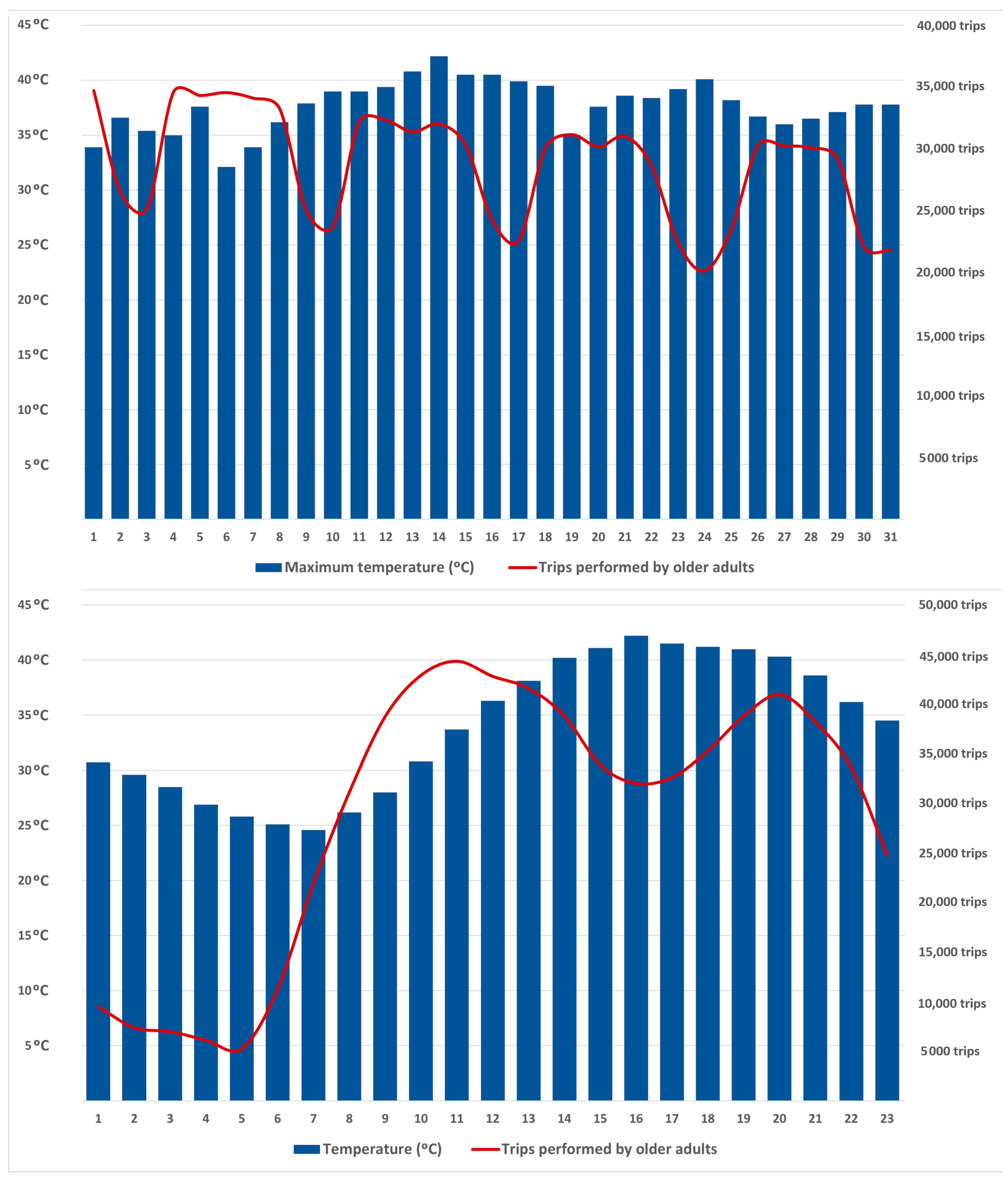
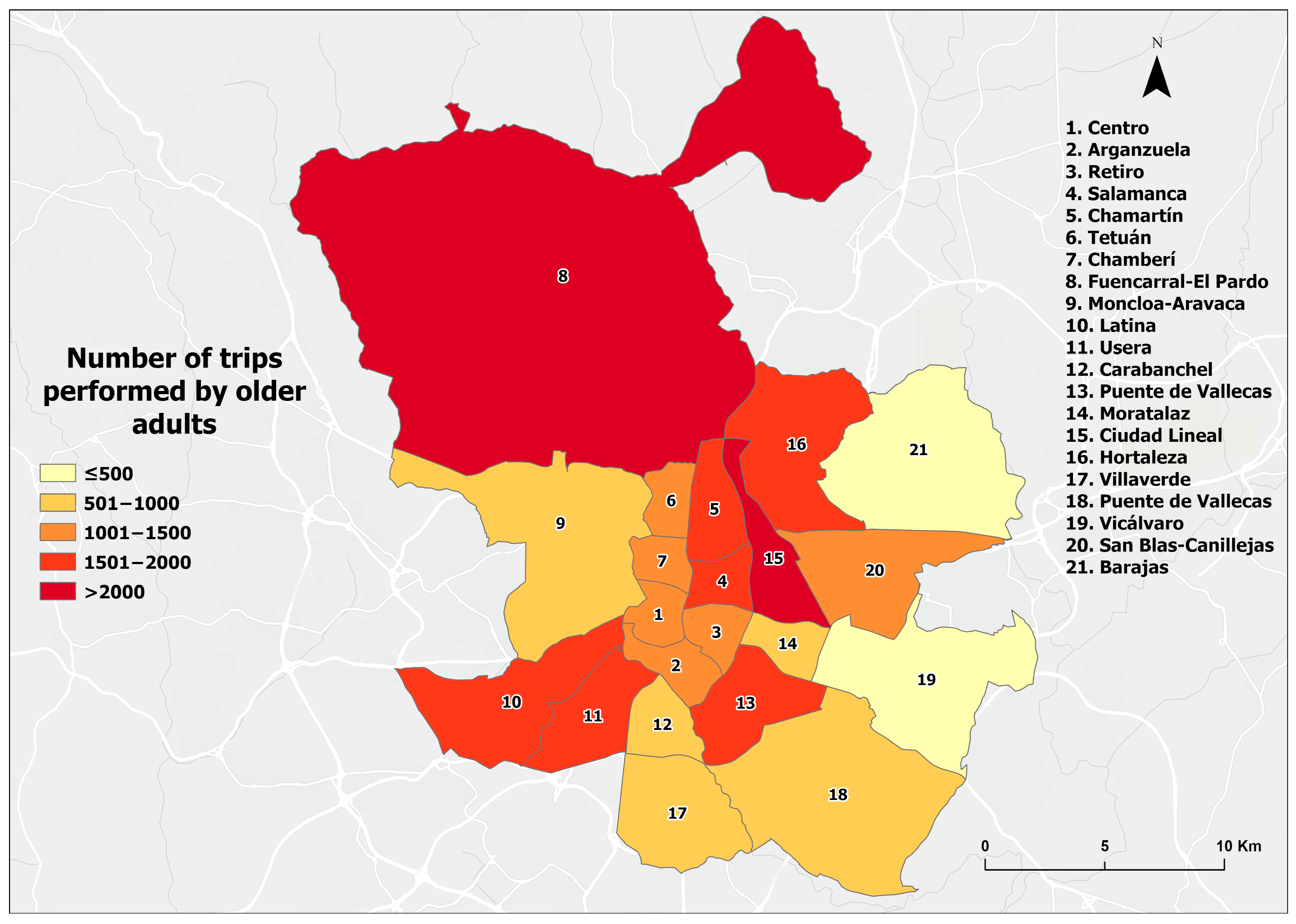
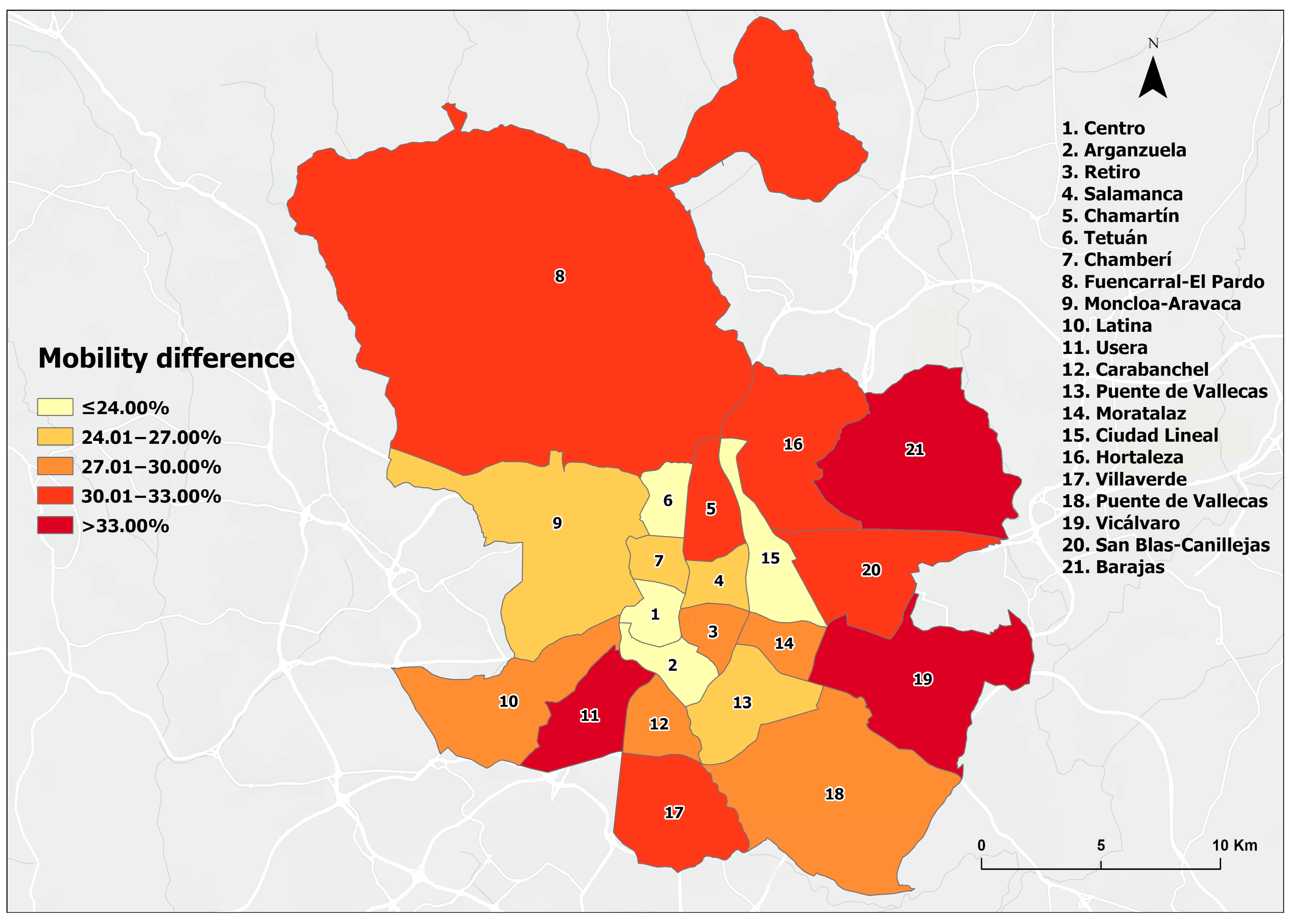


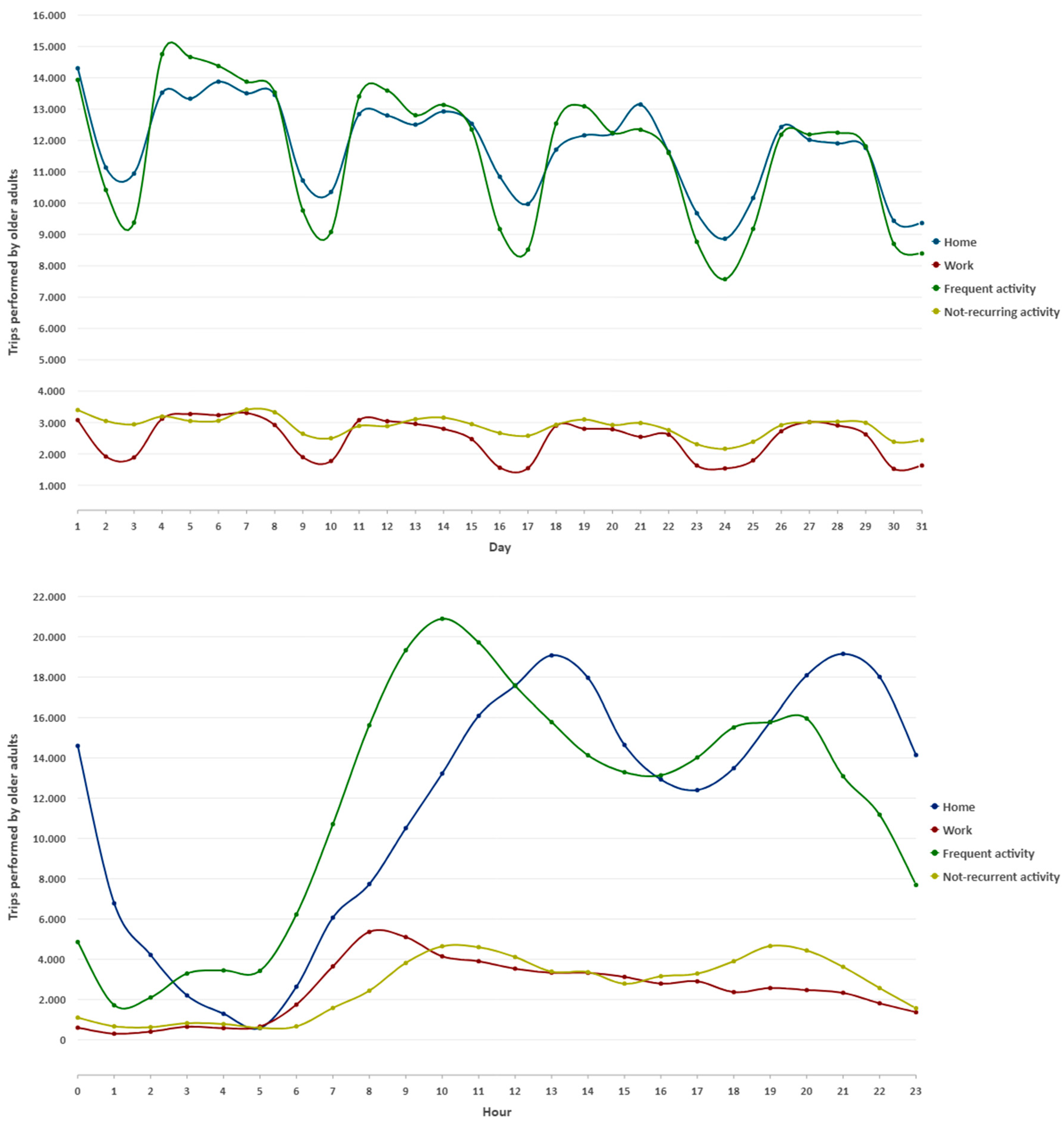
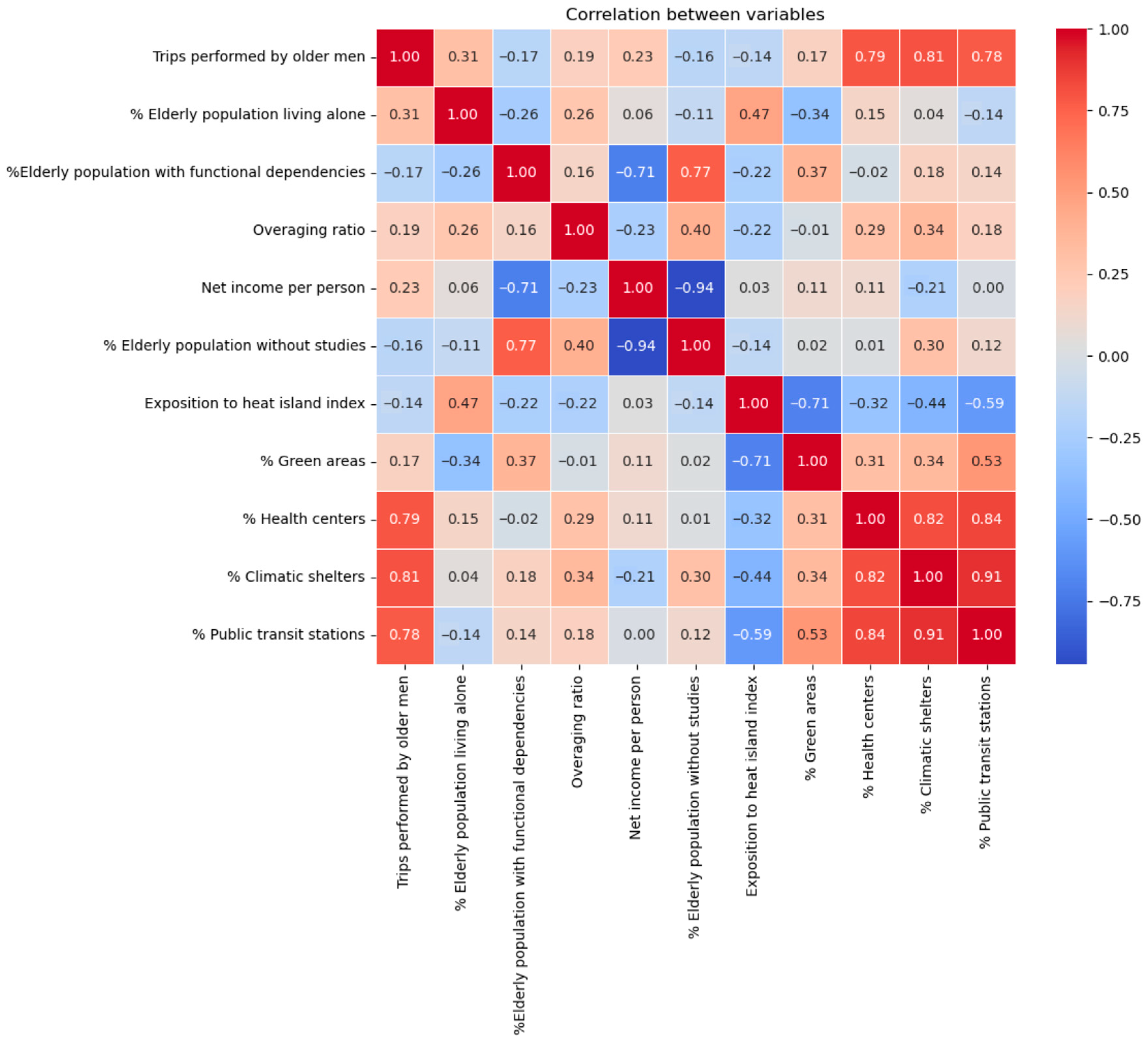
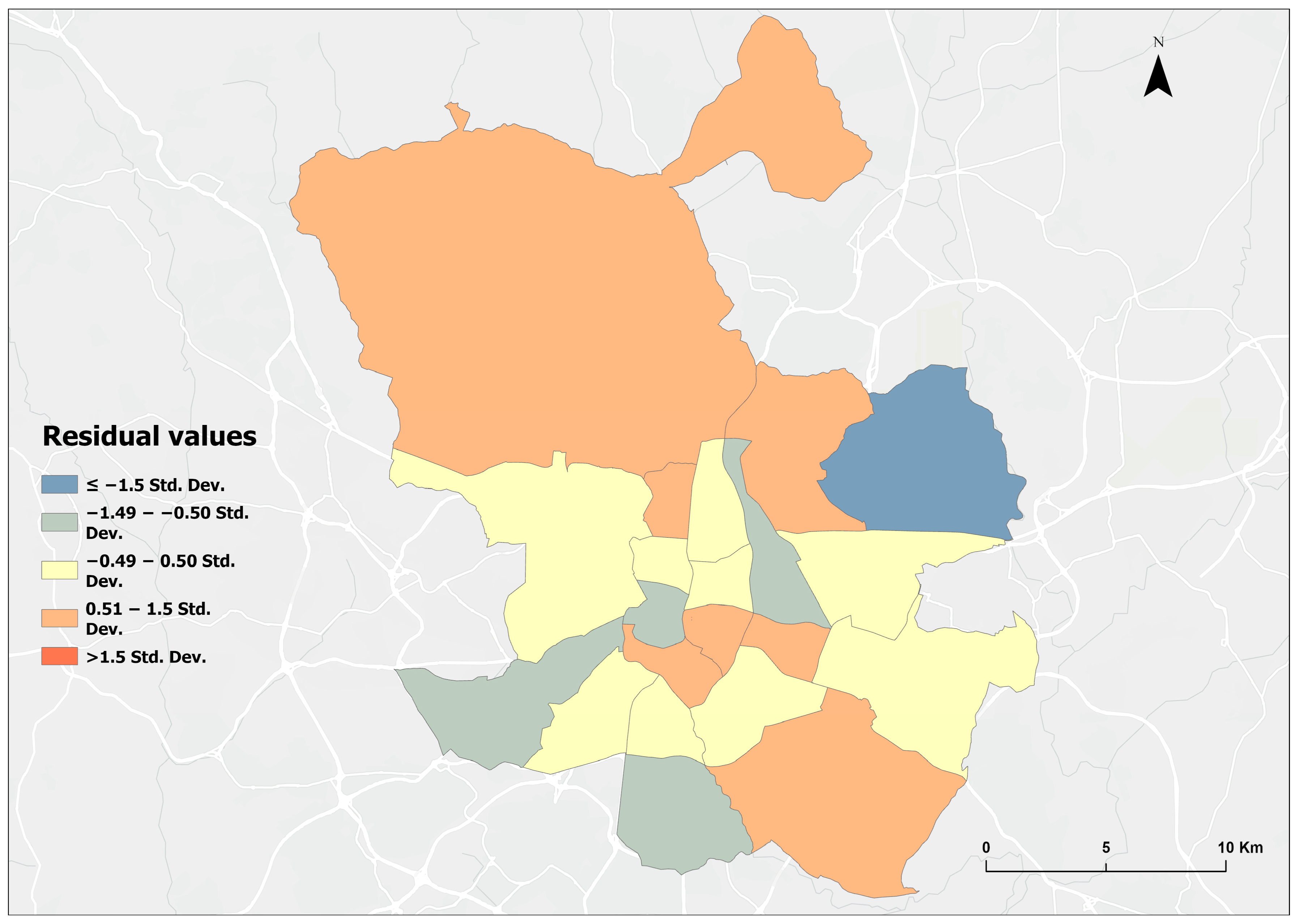
| Dimension | Variable | Type | Source |
|---|---|---|---|
| Mobility | Average number of trips made by individuals aged 65 and older at 4:00 PM in July | Dependent | Spanish Ministry of Transport and Sustainable Mobility (MITMA) |
| Social | Percentage of individuals aged 65 and older living alone | Explanatory | Madrid City Council |
| Social | Percentage of individuals aged 65 and older with functional dependencies | Explanatory | Madrid City Council |
| Social | Percentage of over-aging | Explanatory | Madrid City Council |
| Social | Income level per person | Explanatory | Madrid City Council |
| Social | Percentage of individuals aged 65 and older without primary education | Explanatory | Madrid City Council |
| Environmental | Exposure to the urban heat island effect | Explanatory | Madrid City Council |
| Environmental | Percentage of green areas over total surface area | Explanatory | Madrid City Council |
| Environmental | Percentage of health centers and hospitals per 100,000 inhabitants | Explanatory | Madrid City Council |
| Environmental | Percentage of public spaces converted into climate shelters (shopping malls, senior centers, libraries) per 100,000 inhabitants | Explanatory | Madrid City Council |
| Environmental | Percentage of public transport stops per 100,000 inhabitants | Explanatory | Madrid Community Transport Consortium |
| Variable | Mean | Median | Standard Deviation | Range | Interquartile Range | Coefficient of Variation | Skewness | Kurtosis |
|---|---|---|---|---|---|---|---|---|
| Number of trips during heat wave days | 27,841 | 30,127 | 4104.7 | 12,193.9 | 7286.4 | 0.14 | −0.49 | 1.67 |
| Number of trips during days with normal thermal activity | 30,048 | 30,246 | 4800.1 | 12,898.5 | 7787.7 | 0.15 | −0.59 | 1.94 |
| Model | Unstandardized Coefficients | Standardized Coefficients | t | p-Value | Collinearity Statistics | |
|---|---|---|---|---|---|---|
| B | Typical Error | Beta | IVF | |||
| (Constant) | −1,564,262 | 768,277 | −2036 | 0.061 | ||
| Percentage of older adults living alone | 40,267 | 14,076 | 0.242 | 2861 | 0.013 | 1298 |
| Percentage of older adults with functional dependencies | 21,266 | 11,243 | 0.273 | 1891 | 0.079 | 3791 |
| Percentage of over-aging | −19,331 | 12,637 | −0.128 | −1.53 | 0.148 | 1279 |
| Income level per person | 0.061 | 0.014 | 0.623 | 4474 | 0.001 | 3521 |
| Percentage of green spaces over the total surface area | −11,939 | 5223 | −0.260 | −2286 | 0.038 | 2347 |
| Percentage of public spaces converted into climate shelters per 100,000 inhabitants | 171,745 | 15,375 | 1015 | 11.17 | 0.000 | 1501 |
Disclaimer/Publisher’s Note: The statements, opinions and data contained in all publications are solely those of the individual author(s) and contributor(s) and not of MDPI and/or the editor(s). MDPI and/or the editor(s) disclaim responsibility for any injury to people or property resulting from any ideas, methods, instructions or products referred to in the content. |
© 2025 by the authors. Licensee MDPI, Basel, Switzerland. This article is an open access article distributed under the terms and conditions of the Creative Commons Attribution (CC BY) license (https://creativecommons.org/licenses/by/4.0/).
Share and Cite
Sánchez-González, D.; Osorio-Arjona, J. Pedestrian Mobility Behaviors of Older People in the Face of Heat Waves in Madrid City. Urban Sci. 2025, 9, 236. https://doi.org/10.3390/urbansci9070236
Sánchez-González D, Osorio-Arjona J. Pedestrian Mobility Behaviors of Older People in the Face of Heat Waves in Madrid City. Urban Science. 2025; 9(7):236. https://doi.org/10.3390/urbansci9070236
Chicago/Turabian StyleSánchez-González, Diego, and Joaquín Osorio-Arjona. 2025. "Pedestrian Mobility Behaviors of Older People in the Face of Heat Waves in Madrid City" Urban Science 9, no. 7: 236. https://doi.org/10.3390/urbansci9070236
APA StyleSánchez-González, D., & Osorio-Arjona, J. (2025). Pedestrian Mobility Behaviors of Older People in the Face of Heat Waves in Madrid City. Urban Science, 9(7), 236. https://doi.org/10.3390/urbansci9070236









